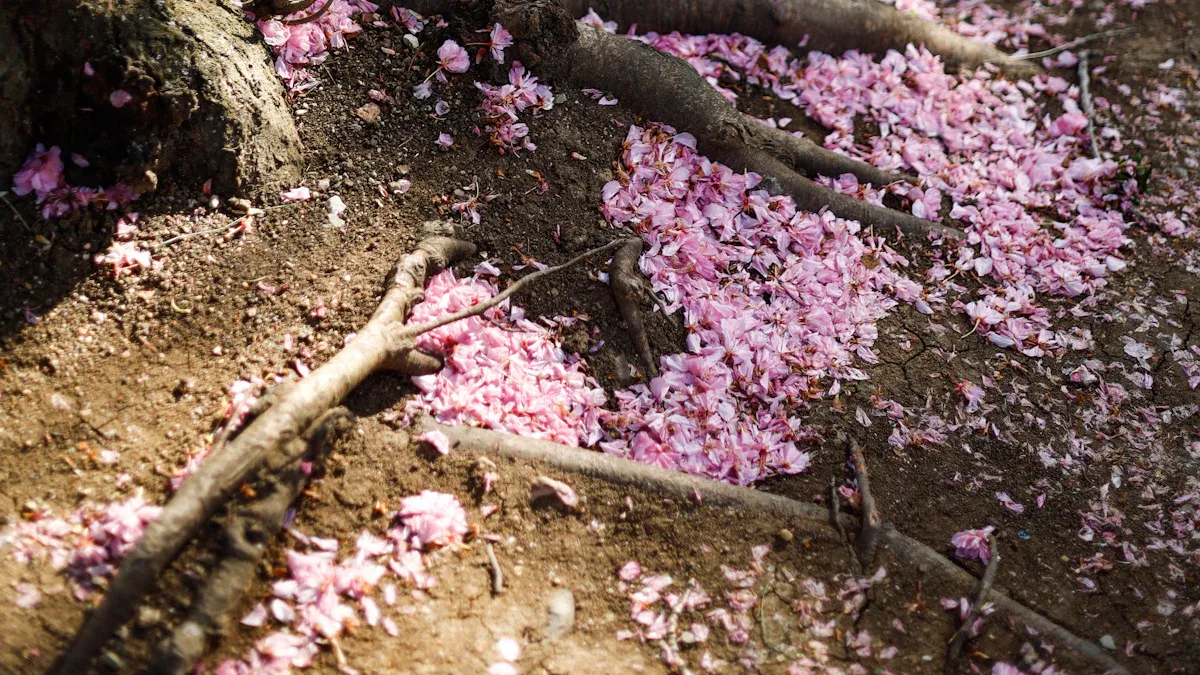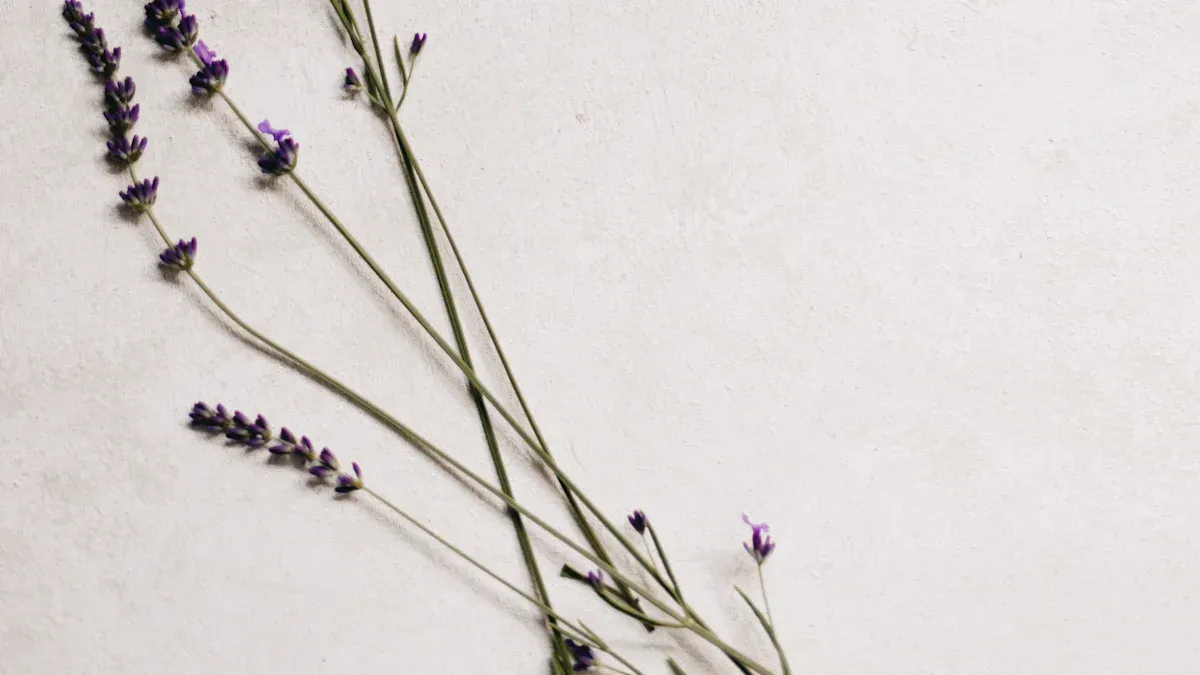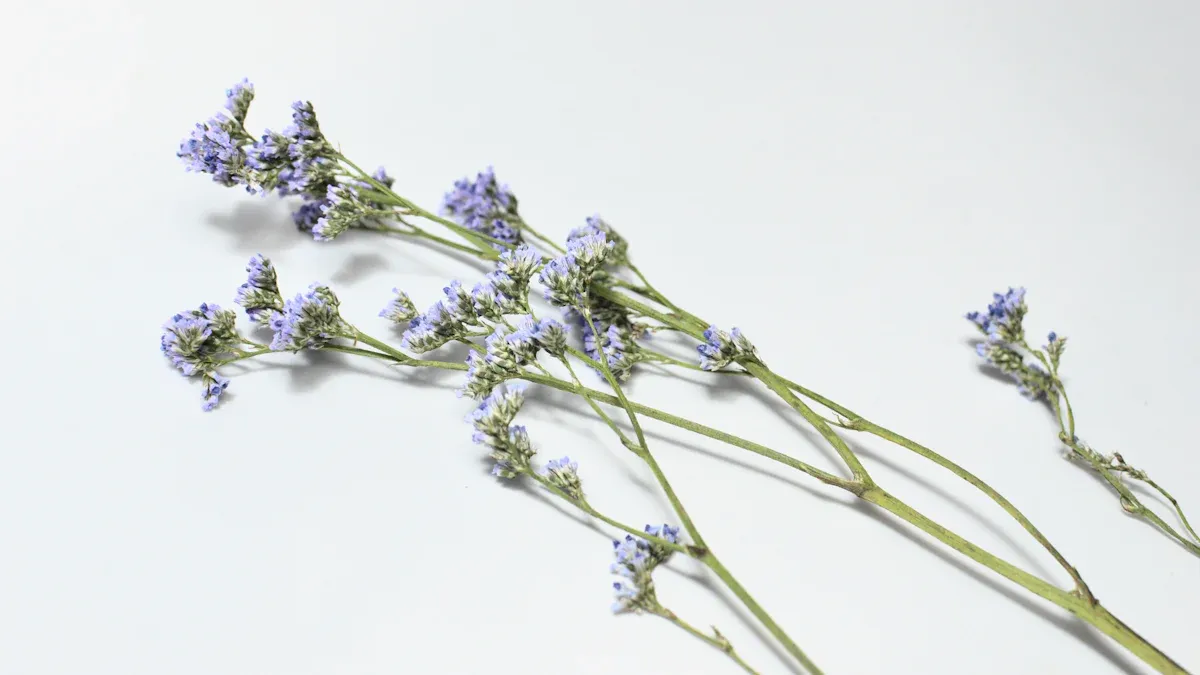
Understanding the anatomy of lavender plant roots and stems is essential for effective plant care. These components directly impact the plant’s overall health and growth. Healthy roots support nutrient uptake and prevent issues like root rot. Sturdy stems provide structure and facilitate the movement of water and nutrients. Proper care leads to vibrant blooms and a resilient garden. For instance, ensuring proper drainage and using compost can significantly enhance lavender’s resilience to diseases.
Evidence Description | Key Insight |
|---|---|
Proper drainage and soil amendments are crucial for lavender health. | Ensures healthy growth and prevents root rot. |
Composted horse manure can enhance resilience against diseases. | Suggested treatment for Phytophthora Crown Root Rot. |
Lavender is drought tolerant and requires minimal watering after establishment. | Important for maintaining optimal conditions in home gardens. |
Key Takeaways
Healthy lavender roots require well-drained soil to prevent root rot. Use coarse sand or gravel to improve drainage.
Water lavender deeply but infrequently. Allow the soil to dry out between waterings to avoid overwatering.
Prune lavender after blooming to maintain shape and encourage new growth. Use sharp tools for clean cuts.
Lavender thrives in full sunlight. Ensure your plants receive 6 to 8 hours of direct sunlight daily for optimal growth.
Understanding the anatomy of lavender roots and stems helps you provide better care, leading to vibrant blooms and a resilient garden.
Lavender Roots

Root Structure
Lavender plant roots exhibit a unique structure that plays a crucial role in their growth and health. Initially, lavender plants develop a single taproot. This taproot seeks deep moisture, allowing the plant to access water during dry periods. As the plant matures, it transitions to a fibrous root system. This fibrous structure consists of a dense network of fine, hair-like roots that typically extend 12 to 18 inches deep.
This design is efficient for absorbing infrequent rainfall. However, it also poses a risk of overwatering. The delicate roots require oxygen and can suffer from root rot if the soil remains overly moist. Therefore, understanding this structure helps you provide the right conditions for your lavender plants.
Root Functions
The functions of lavender plant roots are vital for the overall health of the plant. Roots primarily serve two essential roles: water and nutrient uptake. They absorb moisture and nutrients from the soil, which are crucial for the plant’s growth. Compared to other Mediterranean herbs, lavender roots have specific advantages.
Aspect | Findings |
|---|---|
Mycorrhizal Interaction | Significant effects on root colonization and essential oil percentage (P ≤ 0.05) |
Water Use Efficiency | Inoculation with fungi improved water use efficiency under stress conditions |
Drought Response | Mycorrhizal fungi compensated for drought-induced biomass reduction |
Essential Oil Yield | Highest yield observed under rainfed conditions |
Irrigation Impact | Increasing irrigation intervals helps plants adapt to water stress |
Healthy roots not only support nutrient uptake but also help prevent diseases. Common root diseases can severely impact lavender plants. Pathogenic genera such as Gibberella and Cladosporium can cause significant damage.
Pathogenic Genera | Description of Impact on Lavender |
|---|---|
Gibberella | Associated with wheat scab |
Cladosporium | Common in grapevine diseases |
Alternaria | Causes black rot in carrots |
Fusarium culmorum | Causes seedling blight in wheat |
Ilyonectria liriodendri | Infects grapevines through roots |
Dactylonectria macrodidyma | Infects grapevines through roots |
By ensuring that your lavender plant roots remain healthy, you promote robust growth and vibrant blooms. Proper care, including well-draining soil and appropriate watering practices, can help you maintain the health of these essential structures.
Lavender Stems

Stem Structure
Lavender stems have distinct anatomical features that set them apart from other aromatic herbs. The stems of lavender (Lavandula angustifolia) are circular in cross-section, unlike the square stems found in many other members of the Lamiaceae family. This unique shape contributes to the plant’s overall strength and resilience.
Here’s a comparison of lavender stems with other aromatic herbs:
Feature | Lavender (Lavandula angustifolia) | Other Aromatic Herbs (Lamiaceae) |
|---|---|---|
Stem Cross-Section Shape | Circular | Square |
Types of Trichomes | Covering and Secretory | Varies |
Trichome Morphology | Branched or unbranched covering | Varies |
Secretory Trichomes Types | Peltate and Capitate | Varies |
Stomata Count | Fewer in true lavender | More in lavandin cultivars |
Epidermis Cell Size | Larger in true lavender | Smaller in lavandin cultivars |
These features help lavender withstand various environmental stresses, including drought.
Stem Functions
The stems of lavender serve several important functions that contribute to the plant’s health. They provide structural support for leaves and flowers, allowing the plant to grow upright and capture sunlight effectively.
Pruning lavender directs energy into foliar and root growth instead of seed production.
It takes two to three years for lavender to reach maximum flower and foliage production.
Regular pruning stimulates new growth, which supports the overall health of the plant.
Additionally, lavender stems contain elastic tissues that allow for water mobilization. This feature enables the plant to recover during mild to severe drought stress. However, if the maximum branch shrinkage exceeds 21%, the plant may not recover. High levels of cell damage can lead to drought-induced mortality, making the structural integrity of lavender stems crucial for survival.
By understanding the anatomy and functions of lavender stems, you can better care for your plants. Healthy stems lead to robust growth and vibrant blooms, enhancing your garden’s beauty.
Lavender Care
Caring for lavender involves understanding its specific needs. Proper watering, soil conditions, and pruning techniques are essential for healthy growth and vibrant blooms. Here’s a guide to help you effectively care for your lavender plants.
Watering Practices
Watering lavender correctly is crucial for its health. You should aim to keep the soil slightly dry between waterings. Here are some key points to consider:
Watering Frequency:
For garden beds in Mediterranean climates, water only during prolonged droughts.
If you grow lavender in pots, water regularly but ensure good drainage.
In winter, when the soil is frost-free, water only when necessary to avoid freezing.
Soil Type | Climate Condition | Watering Frequency |
|---|---|---|
Garden Bed | Mediterranean | Water only during prolonged droughts |
Potted Lavender | Varies (indoor/outdoor) | Water regularly, but ensure good drainage |
Frost-free Soil | Winter | Water only when necessary, avoid freezing |
Overwatering can lead to serious issues. It causes drooping leaves and weakens the plant structure. This makes lavender more susceptible to pests and diseases. Consistent watering is especially important for young plants. If you notice yellowing leaves or mushy stems, your lavender may be drowning. On the other hand, underwatering results in dry, crispy leaves and stunted growth.
Soil Requirements
Lavender thrives in well-drained soil. The ideal soil pH for lavender is between 6.5 and 7.5. Here are some tips for creating the right soil conditions:
Use well-draining materials like coarse sand, perlite, or gravel.
Minimize organic matter to mimic lavender’s native Mediterranean environment.
Test your soil pH regularly. If it’s too acidic, add lime to raise the pH.
To improve drainage in clay soils, consider adding:
Coarse sand
Grit or fine gravel
Pumice or perlite
These amendments create air pockets and enhance drainage, which is vital for preventing root rot.
Pruning Techniques
Pruning lavender is essential for maintaining its shape and promoting more flowers. Here are some effective pruning techniques:
Timing:
For English lavender, prune after blooming in late summer. This encourages a significant flush of flowers in spring.
French lavender benefits from regular light trimming throughout the growing season.
Lavender Type | Pruning Timing | Pruning Method |
|---|---|---|
English Lavender | Post-bloom (late summer) | Trim back about one-third; cleanup in early spring; avoid cutting into old wood. |
French Lavender | Throughout the growing season | Regular light trimming; avoid significant cuts in late summer or fall. |
When pruning, use sharp tools for clean cuts. Avoid cutting into old wood, as this can damage the plant. Proper timing is crucial. Cutting back too early can expose new growth to frost, negatively affecting the plant’s vigor.
By following these lavender care practices, you can ensure that your plants remain healthy and productive. With the right watering, soil, and pruning techniques, your lavender will thrive, providing beautiful blooms and delightful scents.
Caring for lavender roots and stems is vital for your plants’ health and longevity. Proper care leads to stronger plants and more vibrant blooms. Here are some key points to remember:
Lavender needs 6 to 8 hours of direct sunlight daily for optimal growth.
Well-drained, slightly alkaline soil prevents root rot and supports plant lifespan.
Water deeply but infrequently to avoid overwatering, which can lead to plant failure.
Regular pruning after flowering maintains shape and encourages vigorous growth.
By following these practices, you not only enhance your garden’s beauty but also increase profitability if you are a commercial grower. Healthy roots and stems lead to higher flower and oil yields, making your lavender cultivation more rewarding.
FAQ
What type of soil is best for lavender?
You should use well-draining soil with a pH between 6.5 and 7.5. Adding coarse sand or gravel improves drainage, mimicking lavender’s native Mediterranean environment.
How often should I water lavender?
Water lavender deeply but infrequently. Allow the soil to dry out between waterings. For garden beds, only water during prolonged droughts.
When should I prune my lavender plants?
Prune English lavender after blooming in late summer. For French lavender, trim lightly throughout the growing season to encourage new growth.
Can lavender survive winter?
Yes, lavender can survive winter, especially in well-drained soil. Protect young plants with mulch to insulate roots from frost.
How can I tell if my lavender is overwatered?
Signs of overwatering include yellowing leaves and mushy stems. If you notice these symptoms, reduce watering immediately to prevent root rot.

